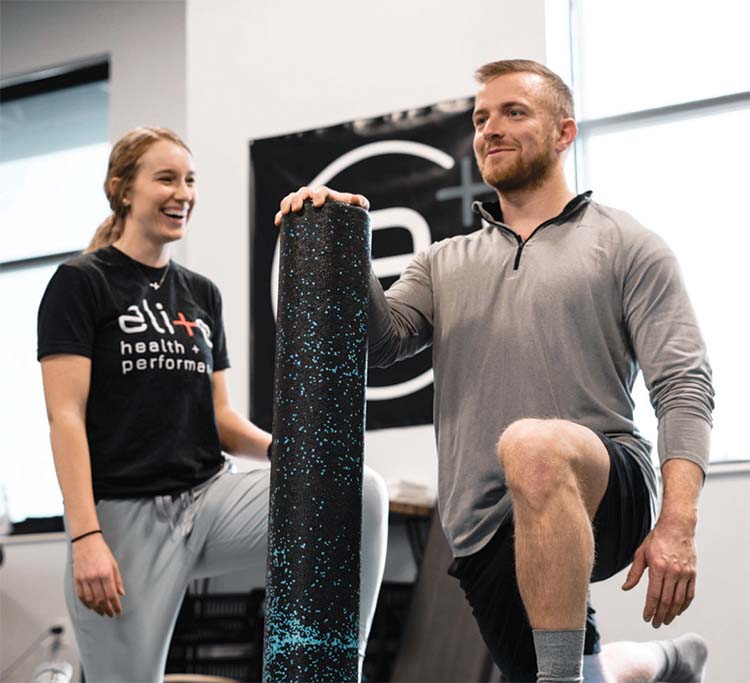Submitted by CAPITAL ORTHO

Physical therapists can help you overcome barriers to physical activity
More than 80 percent of American adults do not get enough physical activity, despite the proven benefits, such as a reduced risk of some cancers and chronic diseases, as well as improved bone health, cognitive function, weight control and quality of life. As a result, half of American adults — 117 million people — have one or more ongoing diseases. The good news is that regular physical activity can help prevent and improve many chronic health conditions.
Capital Ortho Physical Therapy Director Jonathan Thomas said, “Many patients we are treating fall into one of two categories: Either they don’t exercise enough, or they are exercising too much (not having adequate rest).”
Barriers to movement and physical activity can be small or large, real or perceived. Whatever barriers you face, physical therapists can partner with you to create a safe and effective program to get you moving.
Physical therapists are movement experts. They can design plans specific to your age, abilities, needs, challenges and goals. They can work with other members of your healthcare team to maximize your movement.
These 11 barriers to physical activity can be overcome with a little effort and the help of a physical therapist*:
1. ‘It’s too late.’
It’s never too late to get moving. Adding physical activity at any age has benefits — such as an increased lifespan, stress management, memory and brain function improvement, and chronic disease avoidance.
2. Pain
For some people, pain makes movement a challenge. Pain is one of the most common reasons people seek healthcare. A physical therapist can help you move better and safely manage your pain.
3. (Lack of) time
Some physical activity is better than nothing. Try to fit in a few short bursts of physical activity a few times a day for a total of 30 minutes. Make sure that the activity increases your heart rate.
4. Lack of access to a gym or equipment
Dancing, jogging, walking, climbing stairs, and gardening are all physical activities you can do around your home without equipment. Try doing body-weight exercises at least twice a week. Use household objects, e.g., cans or milk jugs.
5. ‘I don’t like exercise.’
Physical activity doesn’t have to involve things you don’t like. Discover the activities you enjoy, and make them part of your daily routine.
6. Lack of motivation or feeling overwhelmed by the challenge
Physical activity releases endorphins, the feeling of well-being you get after a good workout. To get started, offer yourself a small reward each time you’re physically active until it becomes a habit.
Also try:
• Placing walking shoes, hand weights or resistance bands within easy reach of your desk or where you spend the most time.
• Scheduling time for daily physical activity and setting a calendar reminder.
• Tracking your steps daily. Increase your step-count goal each week.
7. Chronic disease, condition or disability
Whether you use a wheelchair or other assistive device or have mobility challenges due to a chronic condition or prior injury, there are activities you can do to improve your health. Physical activity can improve some chronic conditions and prevent others.
8. ‘I’m afraid of hurting myself.’
A physical therapist can help you identify a safe and effective physical activity plan for your age and ability.
9. Shortness of breath during exercise
It’s normal to feel a bit winded when exerting yourself more than usual.
If you worry for any reason that physical activity will be unsafe, contact a physical therapist before you begin. After an evaluation, a physical therapist can help you find the right duration and type of physical activity.
10. No energy
Exercise boosts energy levels. Physical activity also improves brain function, lowers anxiety, promotes better sleep, and aids in weight management. All of these enhance our energy.
11. Failure to reach goals
If you’re having trouble meeting strength and conditioning goals despite your best effort, a physical therapist can help identify any issues and design a program to maximize your movement and enhance performance.
Thomas said, “The best advice when starting any new program is to have a plan. …. A plan will help keep a healthy balance of progress and rest. As Benjamin Franklin once said, ‘If you fail to plan, you are planning to fail.’”
*Much of this information has been adapted from the American Physical Therapy Association.

Jonathan Thomas, PT, is the director of physical therapy at Capital Ortho. In addition to treating patients, he oversees a team of 12 physical therapists and physical therapy assistants in Flowood, Clinton and Madison. Jonathan lives in Brandon with his wife, Brandy, and daughter, Mallory. They are active members of Pinelake Church. He enjoys biking and running in his spare time.